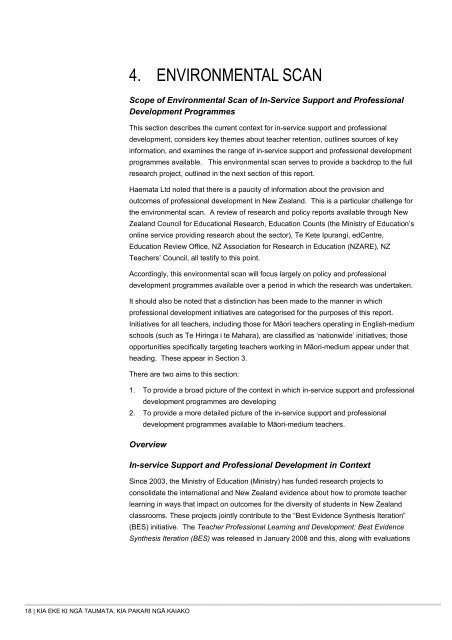Kia eke ki ngÄ Taumata, kia Pakari ngÄ Kaiako He ... - Te Puni Kokiri
Kia eke ki ngÄ Taumata, kia Pakari ngÄ Kaiako He ... - Te Puni Kokiri
Kia eke ki ngÄ Taumata, kia Pakari ngÄ Kaiako He ... - Te Puni Kokiri
You also want an ePaper? Increase the reach of your titles
YUMPU automatically turns print PDFs into web optimized ePapers that Google loves.
4. ENVIRONMENTAL SCANScope of Environmental Scan of In-Service Support and ProfessionalDevelopment ProgrammesThis section describes the current context for in-service support and professionaldevelopment, considers key themes about teacher retention, outlines sources of keyinformation, and examines the range of in-service support and professional developmentprogrammes available. This environmental scan serves to provide a backdrop to the fullresearch project, outlined in the next section of this report.Haemata Ltd noted that there is a paucity of information about the provision andoutcomes of professional development in New Zealand. This is a particular challenge forthe environmental scan. A review of research and policy reports available through NewZealand Council for Educational Research, Education Counts (the Ministry of Education’sonline service providing research about the sector), <strong>Te</strong> Kete Ipurangi, edCentre,Education Review Office, NZ Association for Research in Education (NZARE), NZ<strong>Te</strong>achers’ Council, all testify to this point.Accordingly, this environmental scan will focus largely on policy and professionaldevelopment programmes available over a period in which the research was undertaken.It should also be noted that a distinction has been made to the manner in whichprofessional development initiatives are categorised for the purposes of this report.Initiatives for all teachers, including those for Māori teachers operating in English-mediumschools (such as <strong>Te</strong> Hiringa i te Mahara), are classified as ‘nationwide’ initiatives; thoseopportunities specifically targeting teachers wor<strong>ki</strong>ng in Māori-medium appear under thatheading. These appear in Section 3.There are two aims to this section:1. To provide a broad picture of the context in which in-service support and professionaldevelopment programmes are developing2. To provide a more detailed picture of the in-service support and professionaldevelopment programmes available to Māori-medium teachers.OverviewIn-service Support and Professional Development in ContextSince 2003, the Ministry of Education (Ministry) has funded research projects toconsolidate the international and New Zealand evidence about how to promote teacherlearning in ways that impact on outcomes for the diversity of students in New Zealandclassrooms. These projects jointly contribute to the “Best Evidence Synthesis Iteration”(BES) initiative. The <strong>Te</strong>acher Professional Learning and Development: Best EvidenceSynthesis Iteration (BES) was released in January 2008 and this, along with evaluations18 | KIA EKE KI NGĀ TAUMATA, KIA PAKARI NGĀ KAIAKO
















